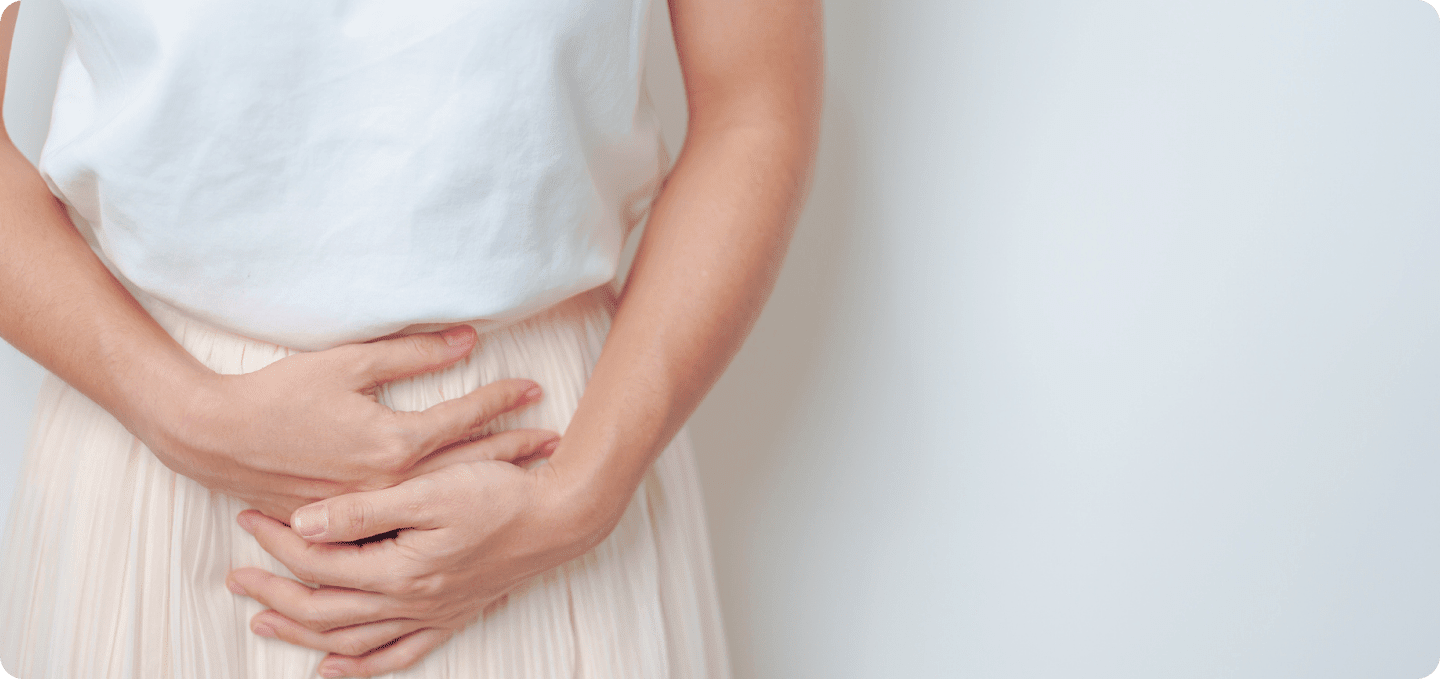Do you want to know what influences the growth of your endometrial lining and how you can support it? Then this article is for you.
Everything You Need to Know About Improving a Thin Endometrial Lining
- A healthy endometrial lining is essential for successful embryo implantation and ultimately a successful pregnancy.
- Estrogen helps the endometrium grow, while progesterone maintains it.
- In about 2.4% of fertility treatments, a lining that is too thin is diagnosed.
- The ideal endometrial thickness in the second half of the cycle is 7–14 mm.
- Raspberry leaves, yarrow, and red clover may support uterine lining growth.
Why the Thickness of Your Uterine Lining Matters
Did you know that your uterine lining could also be a reason for difficulties getting pregnant?
If you’re trying to conceive, your endometrium needs to be thick enough for the fertilized egg to implant. Sometimes the uterine lining remains too thin, making implantation difficult or even impossible.
In this article, you’ll learn what can cause a thin uterine lining and what you can do to help your endometrium build up properly.
A common cause: low progesterone
One frequent reason for implantation failure is a lack of progesterone, also known as luteal phase insufficiency. Without enough progesterone, the uterine lining cannot stay stable for implantation.
At our fertility clinic in Zurich, we check whether your hormones are in balance and help you create the best possible conditions for a healthy pregnancy.
What Role Does the Uterine Lining Play When Trying to Conceive?
The uterine lining, also called the endometrium, is the inner lining of the uterus. Its growth is stimulated by estrogen. Progesterone—the so-called corpus luteum hormone—helps the lining remain stable and supports an early pregnancy.
A review study found that in about 2.4% of fertility treatments, the uterine lining was too thin. This was linked to lower implantation and pregnancy rates.

How Thick Should the Uterine Lining Be?
You may have heard that the uterine lining is made up of three layers. On ultrasound, doctors can clearly distinguish the lining, the muscle tissue, and the uterine cavity. These three parts are separated by visible lines, which is why the term “triple-layered” (or trilaminar) endometrium is often used. Shortly before ovulation, this triple-line pattern is especially easy to see.
But it’s not just the structure that matters—endometrial thickness is crucial for implantation.
- If the lining is too thin, even a fertilized egg cannot implant properly because it lacks sufficient support.
- In some cases, the lining may even become too thick, which can also reduce the chances of implantation.
In general, normal endometrial thickness in the second half of the menstrual cycle is 7–14 mm. Pregnancies can sometimes occur with a thickness of 4–5 mm, but the chances of successful implantation increase significantly once the lining is at least 7 mm.
If fertilization does not occur in a given cycle, the built-up uterine lining is shed with the next menstrual period.

How Can You Naturally Build Up Your Uterine Lining?
A healthy diet and certain supplements play an important role in supporting the uterine lining. Below, we share tips on how to naturally strengthen your endometrium.
Healthy diet and exercise
A balanced, nutrient-rich diet can help nourish and support the uterine lining with essential minerals. Foods such as leafy green vegetables, legumes, whole grains, berries, nuts, seeds, and fish rich in omega-3 fatty acids can promote endometrial growth.
These kinds of lifestyle changes support overall reproductive health and can improve blood flow through the blood vessels of the uterus.
Certain herbs have also traditionally been used to support the uterine lining, including raspberry leaves, yarrow, and red clover:
- Raspberry leaf tea can not only help stabilize the menstrual cycle but also contribute to building up the uterine lining.
- Yarrow stimulates the uterus, increases muscle tone, promotes reproductive activity, and is also effective in relieving menstrual discomfort.
- Red clover, like soy, contains phytoestrogens that act in a way similar to estrogen and may support endometrial development.
If you want to use these herbs, it is essential to discuss the exact dosage and duration of use with your gynecologist.
You should also make sure to get enough physical activity. One reason for insufficient endometrial development can be reduced blood flow. Endurance training not only boosts your circulation but can also increase blood flow to the uterus, thereby promoting the growth of the uterine lining.
Supplements
Certain dietary supplements can also help build up the uterine lining, including L-arginine, vitamin E, and omega-3 fatty acids.
- L-arginine: According to studies, L-arginine increases blood flow in the uterine arteries and the endometrium. It improved endometrial thickness by 67% and blood flow by 89% in patients with a thin uterine lining (<8 mm).
- Vitamin E: An analysis on the effectiveness of vitamin E showed that oral intake supports endometrial growth in women of reproductive age, especially in those with a thin uterine lining.
- Omega-3 fatty acids: Omega-3s play an important role in the body by helping produce prostaglandins, estrogen, and progesterone—hormones that support the development of the uterine lining and prepare it for pregnancy.
Acupuncture
Acupuncture can help increase blood flow to the uterus and thereby promote the growth of the uterine lining. One study found that not only did the thickness of the endometrium improve, but also pregnancy rates and embryo transfer rates increased.
Stem cell therapy
If the growth of the uterine lining is restricted by (chronic) conditions such as endometriosis or Asherman’s syndrome, stem cell therapy could become a treatment option in the future. Studies have shown that mesenchymal stem cells derived from bone marrow (precursor cells that can develop into different cell types) may promote the regeneration of the endometrium.
Emerging therapies, such as platelet-rich plasma (PRP) applied directly to the uterus, are also being studied as potential treatments to regenerate a thin endometrial lining.
Common Causes of Thin Endometrium
The causes of a thin uterine lining are, in most cases, related to poor blood flow or a hormonal imbalance:
- Poor blood circulation: Inadequate blood flow is the most common reason for a uterine lining that is too thin. It can help to lower cholesterol levels, avoid sitting for long periods, and engage in regular physical activity to stimulate uterine blood flow.
- Hormonal imbalance: If your hormone levels are not balanced, your menstrual bleeding may not only become irregular, but the uterine lining may also fail to develop adequately. In most cases, this is due to low estrogen levels, especially in women with PCOS (polycystic ovary syndrome) or during the transition to menopause.
- Clomiphene: Clomiphene citrate is used in many countries to stimulate egg maturation. However, one possible side effect is a thin uterine lining.
- Chronic endometritis: In rare cases, women may develop an inflammation of the uterine lining (endometritis) after childbirth. Patients with chronic endometritis may show a thin uterine lining on ultrasound.
- Endometriosis: Endometriosis can make it difficult to conceive in many ways. Scar tissue or adhesions in the ovaries or fallopian tubes can cause infertility. In addition, the associated hormonal imbalance and progesterone deficiency may prevent the uterine lining from remaining stable.
- Thyroid disorders: Both overactive and underactive thyroid function can affect fertility. Thyroid hormone (TSH) and sex hormones such as estrogen—which is essential for building the uterine lining—are closely connected. A TSH level that is too low can therefore affect endometrial thickness.
- Asherman’s syndrome: An infection or surgery in the uterus can lead to scarring of the endometrium, resulting in irregular cycles or even amenorrhea (absence of menstruation).
Learn more about possible causes in the podcast with Dr. Natalie Crawford:
How is Endometrial Thickness Diagnosed?
To evaluate the health of the uterine lining, doctors use several diagnostic tools. The first step is often an ultrasound scan, especially a transvaginal ultrasound, which can measure endometrial thickness and check whether it falls within the range of normal endometrial thickness.
If doctors suspect abnormal endometrial lining thickness, further tests may be recommended, such as a saline sonohysterography or a hysteroscopy, which allow a closer look inside the uterus.
In some cases, an MRI can provide detailed imaging. To assess underlying hormonal issues, hormone testing and blood tests are carried out, since imbalances can directly affect the growth of the lining. An endometrial biopsy may also be performed to examine tissue samples under a microscope and rule out abnormalities. Together, these diagnostic methods give a clear picture of uterine and endometrial health and guide the best treatment approach.
Takeaway: Nutrition Plays a Key Role in Uterine Lining Health
Pregnancy depends on a complex interaction of factors: the right timing of sperm and ovulation, open fallopian tubes, and a sufficiently developed uterine lining. In some cases, chronic conditions such as endometriosis, chronic endometritis, or thyroid disorders can lead to a thin uterine lining, which makes implantation of a fertilized egg more difficult—or even impossible.
In many cases, you can naturally support your endometrial health through nutrition, supplements, and positive lifestyle changes. If you are taking clomiphene as part of hormonal treatment, keep in mind that it may negatively affect your endometrium. In this case, you should definitely consult your gynecologist for advice.
A gynecological examination and/or cycle monitoring can give you clarity about whether your uterine lining is sufficiently prepared for a possible pregnancy.
Frequently Asked Questions About Improving Thin Uterine Lining
Can my uterine lining be permanently affected by a dilation and curettage (D&C)?
A curettage of the uterine lining, also known as a D&C, is often performed after a miscarriage to remove retained tissue from the uterus. In most cases, a single D&C has no lasting impact on the thickness or development of the uterine lining. However, repeated procedures may affect the endometrial tissue and lead to a temporary reduction in thickness. In some cases, scarring inside the uterus can occur, especially when curettage is performed repeatedly due to certain conditions or complications.
Can I undergo fertility treatment even with a thin uterine lining?
During an IVF cycle, a thin endometrial lining can lower the chances of live birth, but personalized hormone therapy or regenerative approaches may improve outcomes.
If you are considering fertility treatment despite having a thin uterine lining, you should first discuss this with a reproductive medicine specialist or a gynecologist. Treatment options can vary depending on the individual case. It is important to clarify the exact cause of the thin lining beforehand. Your doctor may order tests and examinations to determine the reason.
During fertility treatments such as in vitro fertilization (IVF) or intracytoplasmic sperm injection (ICSI), a thin endometrium can affect the implantation of embryos. In such cases, specific protocols, medications, or techniques may be used to improve the chances of successful implantation.







